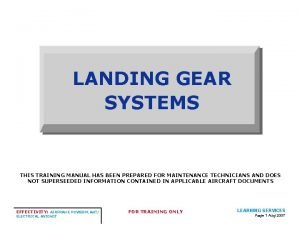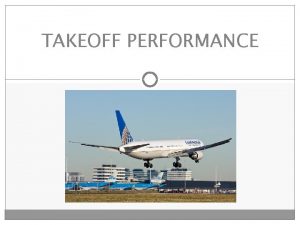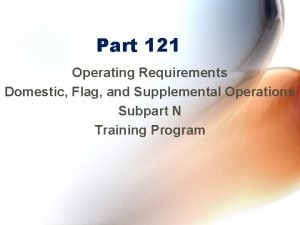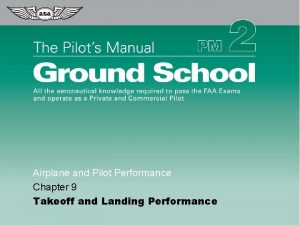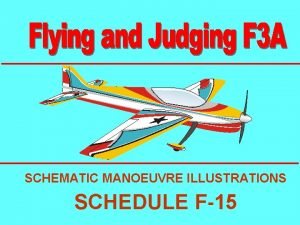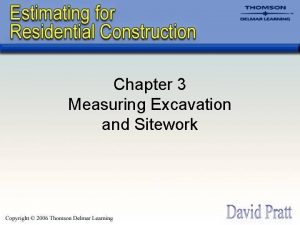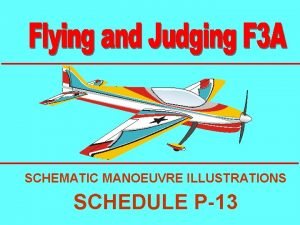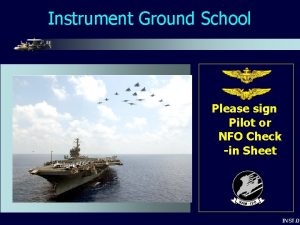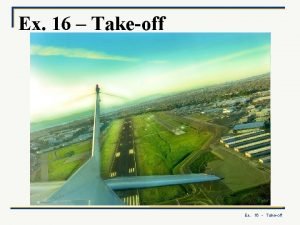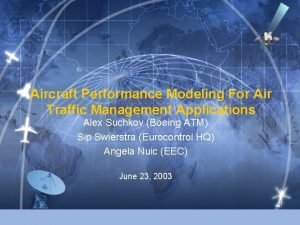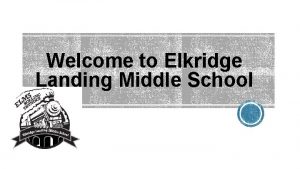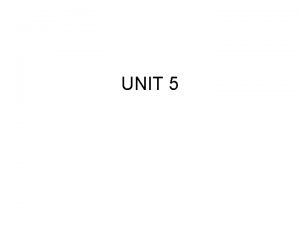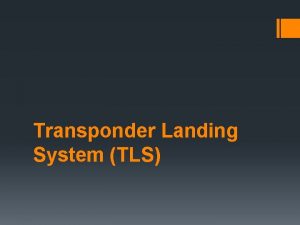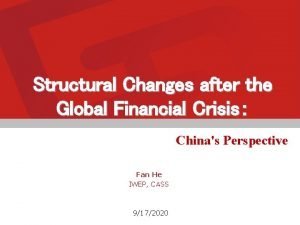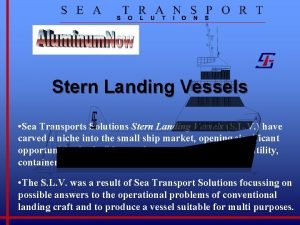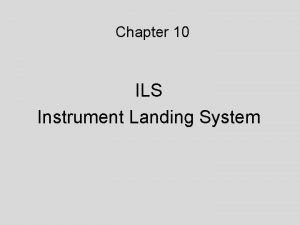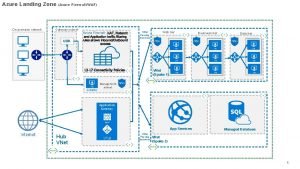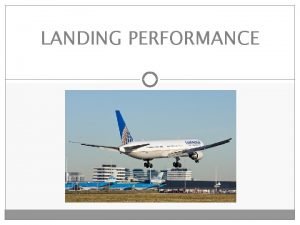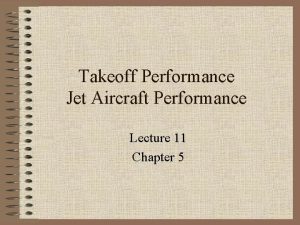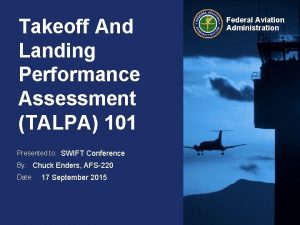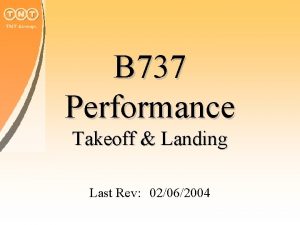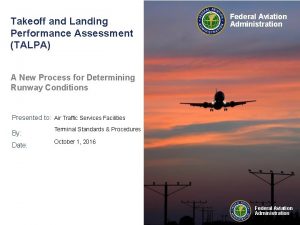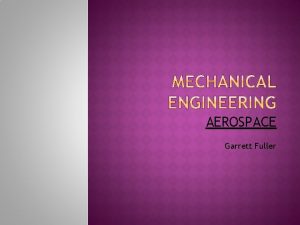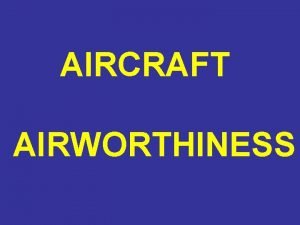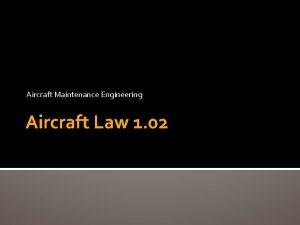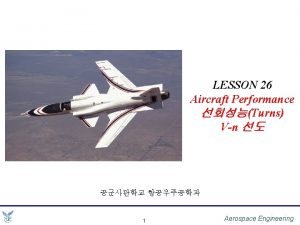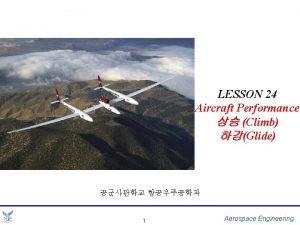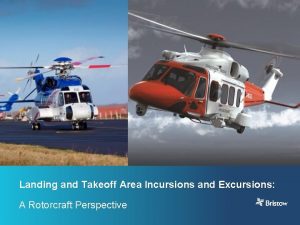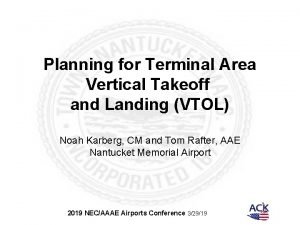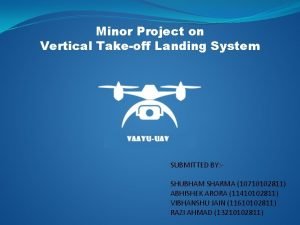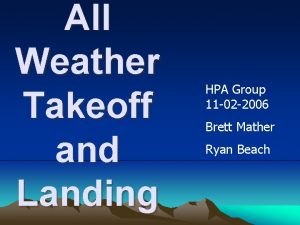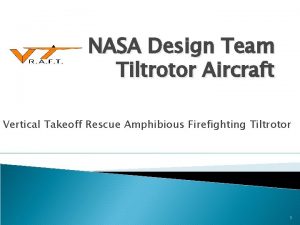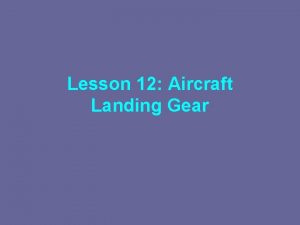LESSON 25 Aircraft Performance TakeOff Landing 1 Aerospace


























- Slides: 26

LESSON 25 Aircraft Performance 이륙 (Take-Off) 착륙(Landing) 공군사관학교 항공우주공학과 1 Aerospace Engineering

Lesson Outcomes § Review § Takeoff Distance (이륙 거리) § Landing Distance (착륙거리) 2 항공공학개론

Review gli Max Powered Endurance d. E E R Glide Range R cruis. EMax RE R Max Powered Range Max Glide Endurance 3 항공공학개론

Review : Some Relationships Case Equation Relation between CDo & KCL Graphical Max Rate of Climb No Set Relation Find greatest distance between PA and PR Max Climb Angle CDo = k. CL 2 Find greatest distance between TA and TR Max Range Average Value Formula or CDo = 3 k. CL 2 (D/V)Min CDo = k. CL 2 TR, Min (L/D)Max Glide Range CDo = k. CL 2 TR, Min (L/D)Max Min Sink Rate 3 CDo = k. CL 2 PR, Min Breguet Range Eq. 5. 27 Max Endurance Average Value Formula or Breguet Endurance Eq. 5. 27 4 항공공학개론


(3) Drag Polar 문제인 경우: A) Induced drag와 Parasite drag와 관계 찾기 CDo= k. CL 2 or 3 CDo= k. CL 2 or B) Find CL from relationship of CDo and k. CL 2 CDo= 3 k. CL 2 Or C) Find V from: D) Find CD from CD = CDo + k. CL 2 E) TR = D = CD q S 6 항공공학개론

(4) Chart 문제인 경우 glid. ER cruis. ER T Endurance means RODmin E RE R V Chart PR, min (go to Power charts, find the lowest pt) Drag Polar 3 CDo = k CL 2 TR, min and L/D)max D/V)min CDo = k CL 2 7 CDo = 3 k CL 2 항공공학개론

Review : 상승 문제인 경우 Max climb angle Max climb rate ROCmax = Px, max / W Gammamax = acrsin(Tx, max / W) Px, max occurs at the pt where a line parallel to PA is tangent to the PR curve Tx, max occurs at TR, min T TR PR P PA TA Tx, max Px, ma x V for TR, min V V 8 항공공학개론

Approach Desired performance parameter: distance ─ Takeoff: brake release to liftoff ─ Landing: touchdown to full stop Sum forces acting during takeoff or landing roll Knowing the acceleration from Newton’s 2 nd Law, integrate with respect to time twice to find distance Climb Over Obstacle Transition s. TO 9 항공공학개론

Forces at Takeoff (Takeoff EOM) L D T N x N = W-L W N is the coefficient of rolling friction = (0. 02 ~ 0. 05 for dry concrete) SFx = ma = W –g a = T – D – (W-L) 10 항공공학개론

Takeoff Distance v Assume acceleration is constant, a v Integrate to velocity and takeoff distance 11 항공공학개론

Takeoff Distance v Combining acceleration and distance: v Now, for VTO By FAA regulation: VTO = 1. 2 VSTALL VTO = 1. 2 2 W r S CLMAX v Then Evaluate average forces at 0. 7 VTO 12 항공공학개론

Takeoff Simplified v If we assume T >> all retarding forces, i. e. , T >> D – m (W-L) 2 1. 44 WTO STO = r S CLMAX g T v We can break this up into two important ratios STO = 1. 44 r CLMAX g ( )(T) WTO S Wing loading WTO (Thrust to weight ratio) -1 Light A/C 30 -40 lb/ft 2 Fighters 65 -75 lb/ft 2 Transports 120 -130 lb/ft 2 13 항공공학개론




이륙거리 Sensitivities STO = ( )(T) 1. 44 r CLMAX g WTO STO v High Lift devices ? v Increase Weight ? v Higher Wing Loading ? v Higher Thrust to weight ratio ? v Higher Altitude (low r and T) ? 17 항공공학개론

Takeoff Distance 18 항공공학개론

Examples STO = ( )(T) 1. 44 r CLMAX g WTO S WTO v If an aircraft has a sea level takeoff distance of 3, 100 ft with CLMAX (with flaps) = 1. 3, what is the STO without flaps (CLMAX = 0. 9)? v Same aircraft with 30% higher weight? v Same aircraft taking off at 20, 000 ft? 19 STO = 4478 ft STO = 5239 ft STO = 5816 ft 항공공학개론

Design Considerations: Takeoff To minimize takeoff distance: v Maximize thrust to weight ratio (T/W) v Minimize wing loading (W/S) v Maximize lift coefficient (high lift devices) 20 항공공학개론

착륙성능 : Forces at Landing and EOM L D T N x N = W-L W N is the coefficient of friction for braking = (. 4 -. 6 for dry concrete) 0 –g a = T – D – (W-L) SFx = ma = W 21 항공공학개론

Landing Distance v Similar development except: § Assume T=0 § Cannot ignore drag and rolling friction The decelerating force is: We still must use the average value of lift and drag: is the landing (touchdown) velocity 22 항공공학개론

Landing Distance By FAA regulation: 23 항공공학개론

Design Considerations: Landing To minimize landing distance: v v v Employ high lift devices to land as slow as possible Use drag chutes and/or speed brakes to increase drag Brake technology is usually a limiting factor Use spoilers to reduce lift/put more weight on wheels Reverse thrust 24 항공공학개론

Ground Effect “Ground effect” is the name given to the phenomenon that occurs when an aircraft is flying within about a half-span distance (b/2) from the ground during takeoff and landing. When an aircraft is flying in ground effect, the strength of the wingtip vortices is diminished due to the ground obstructing the flow around the wingtips. The effective wing span (and therefore the effective aspect ratio) of the aircraft increases. As a result, induced drag is decreased and lift is increased. Ground effect causes an aircraft to “float” during takeoff and landing. Images from Wingship, Inc. 25 항공공학개론

Other Factors Affecting TO and Landing Distances How will each of these affect the two distances? Ø Headwind Decreases takeoff distance _______ Decreases landing distance _______ Ø Upsloping runway Increases takeoff distance _______ Decreases landing distance _______ Ø Wet or icy runway Slight Inc. takeoff distance _______ Increases landing distance _______ Ø Ground effect Decreases takeoff distance _______ Increases landing distance _______ 26 항공공학개론
 Gear
Gear Aircraft landing gear system
Aircraft landing gear system Gross takeoff weight
Gross takeoff weight Part 121 captain minimums
Part 121 captain minimums Phlbo
Phlbo Takeoff flaps
Takeoff flaps F-15 schematic
F-15 schematic How to estimate excavation and backfill
How to estimate excavation and backfill Pull-push takeoff
Pull-push takeoff Opencore takeoff delay
Opencore takeoff delay Cnaf 3710 alternate requirements
Cnaf 3710 alternate requirements Ex 16
Ex 16 Vertical game
Vertical game Elkridge landing middle school
Elkridge landing middle school Imos landing page
Imos landing page Landing direction indicator is placed at the
Landing direction indicator is placed at the Transponder landing system
Transponder landing system Tennis game theory
Tennis game theory Soft landing
Soft landing Stern landing vessel
Stern landing vessel Marketo landing page templates
Marketo landing page templates Fox landing catalina island
Fox landing catalina island Eagles landing middle school website
Eagles landing middle school website Components of instrument landing system
Components of instrument landing system Azure firewall hub and spoke
Azure firewall hub and spoke Soft landing
Soft landing What do male ladybugs look like
What do male ladybugs look like
